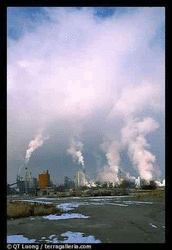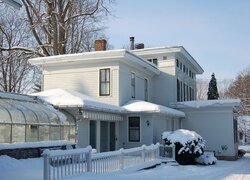OK then we will begin here with the comparisons I suppose:
1. The home and conditions:
I live in North Central Indiana, in the country close to Kokomo
I am heating a 100 year old farm house that is 3300 square feet of a well insulated (R38 in celings / R19 in the walls) two story home using a forced air furnace for the upstairs and a forced air furnace for the downstairs
I have little to no windbreak (come on planted trees, grow), and the wind really whips around here, especially in fall, spring, and winter
My typical propane bills (prior to the boiler installed in March 2005) were about $2000/year with two 90+ furnaces and a tankless hot water heater
I have always used digital kickback thermostats with the following settings: 445am 70, 7am 50, 430pm 70, 930pm 60
2. The boiler:
It is a Woodmaster 4400 made with mild steel, 125 gallons of water, fan induced draft
Woodmaster themselves said that the stainless steel is not a good value for the money and they sell stainless also. My friend with a Central Boiler was told the same thing by their engineers as well.
It sets about 30 feet from the house
1" pex line buried about 34" in the ground
Smoke looks like when you first start a campfire for about 10 minutes then it goes away, while idle, smoke looks about like what comes off of a big fat cigar
I use it to run my upstairs furnace, my down stairs furnace, and heat my water
Boiler does NOT run year round, it is not worth the effort (to me) to run it in the summer just to heat our domestic water
Boiler typically runs from mid October to mid May so like 7-8 months total per year
3. The wood:
I burn any kind of wood from pine (in the cooler months) to hardwoods (in the midst of winter) and telephone poles ($1.00 each from our local utility) that are used for those sub-zero days and nights with the really low wind chills
My neighbor is a tree trimmer so I have an unlimited supply of fire wood
Many of my co-workers donate their fallen down trees if I will cut up and remove
In the town I work, there is a saw mill that makes pallets (from hard wood only) you can buy their scrap, typically 8" x 8" x 24" to 36" for $20.00. That is two dumps onto your trailor, truck etc. from their 5 cubic yard payloader. When its all said and done, thats about a cord of hardwood for $20.00. This is good to use if you are in a pinch because of snow or whatever.
4. Filling the boiler:
This element is so dependat on the weather so it is nearly impossible to judge. If the wind is blowing from the NW at 15-MPH but the outside temp is 32, I will burn much more wood then if the outside temp is 0 with no wind. Wind is my nemisis.
I most generally fill the boiler 2 times per day. At 6am then again at 5pm to get this type of times between fill ups, you must adjust what TYPE of wood that you use as seen above with the pine, hardwood, telephone poles example above.
I do go out often to stoke the fire. Just because I like an excuse to go outside. While I am out there, maybe I throw in a log or two each time.
5. Total amout of wood used per heating season:
I have only had my boiler for two complete seasons (now entering the third) and I estimate that I burn between 9-12 cords per year again depending on the wind.
It is hard to really judge though since I am always picking up a little wood here or there.
Right now, I have 10 cords cut and split since spring, and the boiler is going. But, on nicer days (even in January) the boys and I will go cut a truck load on the weekends just for somethibng to do.
6. The problems:
The little glass jelly jar light cover on the front of the boiler does not stay on very well
Hope that this gets everyone started so that we can do some comparisons. If we all follow this same format, it should be easy to decipher for people.
 .
. .
.


